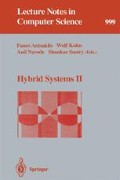Abstract
This paper deals with processing and storage methods for large volume industrial process data measurements which enable the utilization of historical data for process understanding. In the context of hybrid systems, the focus is upon the steps commonly lumped under the category of analog to digital conversion (ADC), which is the interface between the continuous time world of the industrial process and the discrete time world of digital processing. In both cases a hybrid systems viewpoint prevails where continuous variable, discrete variable, and discrete event activities occur.
A fundamentally different paradigm for signal processing is present based upon interval, rather than point set, mathematics. The advantages of this approach include: (1) a hierarchical signal processing structure with decreasing resolution at higher levels of the hierarchy, yet with a common mathematical structure at all levels of the hierarchy; (2) orders of magnitude reduction in the storage and processing requirements of signals as one moves up the hierarchy, and (3) efficient localization of and access to detailed information from higher level information. Because of the paradigm shift to interval mathematics and the structure of signal data (signal objects), we refer to these methods as Object Oriented Signal Processing.
Signal objects can be placed in categories which are automatically derived from the characteristics of the measurement data. This lends a symbolic character to this “signal material” and provides a linkage between the largely numeric processing steps of data collection and the primarily symbolic processing steps of data analysis using methods grouped under the general heading of “intelligent signal processing” or “intelligent control”, such as automata, fuzzy sets, rule based expert systems, and linguistic processing. In effect, the relationships between condensed signals can be characterized by discrete event models, with access to underlying details. The same approach can be taken in the reverse direction, and provides linkage from intelligent control schemes to manipulated variables of the industrial process. The result is an abstract model and control strategy implemented within a discrete event, or hybrid systems, framework which utilizes condensed process information.
Preview
Unable to display preview. Download preview PDF.
References
Beran, Ladislav. Orthomodular Lattices. D. Reidel, Boston, 1984.
Fishburn, Peter C. Interval Orders and Interval Graphs: A Study of Partially Ordered Sets. Wiley, New York, 1985.
Kozub, D. J. and Garcia, C. E., “Monitoring and diagnosis of automated controllers in the chemical process industries,” AIChE meeting, St. Louis, MO, November, 1993.
Lax, R. F. Modern Algebra and Discrete Structures. Harper Collins, 1991.
McLarty, Colin. Elementary Categories, Elementary Toposes. Oxford Univ. Press, Oxford, 1992.
Wiener, N., “A contribution to the theory of relative position,” Proc. Camb. Philos. Soc., 17, 441–449, 1914.
Author information
Authors and Affiliations
Editor information
Rights and permissions
Copyright information
© 1995 Springer-Verlag Berlin Heidelberg
About this paper
Cite this paper
Birdwell, J.D., Moore, B.C. (1995). Condensation of information from signals for process modeling and control. In: Antsaklis, P., Kohn, W., Nerode, A., Sastry, S. (eds) Hybrid Systems II. HS 1994. Lecture Notes in Computer Science, vol 999. Springer, Berlin, Heidelberg. https://doi.org/10.1007/3-540-60472-3_3
Download citation
DOI: https://doi.org/10.1007/3-540-60472-3_3
Published:
Publisher Name: Springer, Berlin, Heidelberg
Print ISBN: 978-3-540-60472-3
Online ISBN: 978-3-540-47519-4
eBook Packages: Springer Book Archive

